Identifying Potential Leakage Zones in an Irrigation Supply Channel by Mapping Soil Properties Using Electromagnetic Induction, Inversion Modelling and a Support Vector Machine
Abstract
1. Introduction
2. Materials and Methods
2.1. Study Site
2.2. DUALEM Data Collection
2.3. Soil Sampling and Laboratory Analysis
2.4. Inversion Modelling Using EM4Soil
- (i)
- Forward modelling—forward calculations and derivatives consider two functions: The cumulative function (CF) is satisfactory if the ECa is measured at low induction numbers; however, the full-solution (FS) would be preferred when the ECa is acquired over conductive terrain (i.e., >100 mS m−1). The latter, therefore, better accounts for nonlinearity.
- (ii)
- Inversion algorithms—include S1 and S2, whereby the latter constrains EMCI variations around a reference model. It generally produced smoother EMCI than S1. Both are variations of Occam regularisation.
- (iii)
- Damping factor (λ) and iterations—as λ increases, it tends to smooth the EMCI. Herein, we considered λ = 0.07, 0.3 and at 0.3 increments thereafter, to a maximum of 3.0. A similar effect occurs when choosing the number of iterations. We selected 10.
2.5. Establishing a Calibration Model between the σ and Various Soil Properties
2.6. Validation and Evaluating Prediction Accuracy, Bias and Concordance
3. Results and Discussion
3.1. Spatial Distribution of ECa
3.2. Preliminary Data Analysis of Soil Physical and Chemical Properties
3.3. Relationship between the σ and Soil Variables
3.4. Measured Versus Predicted Soil Properties
3.5. Mapping Soil Properties with Depth and Along the Channel
4. Conclusions
Author Contributions
Funding
Acknowledgments
Conflicts of Interest
References
- Triantafilis, J.; Ward, W.; McBratney, A. Land suitability assessment in the Namoi Valley of Australia, using a continuous model. Soil Res. 2001, 39, 273–289. [Google Scholar] [CrossRef]
- Stannard, M.; Kelly, I.D.; New South Wales Water Resources Commission. The Irrigation Potential of the Lower Namoi Valley; Water Resources Commission: Sydney, NSW, Australia, 1977. [Google Scholar]
- Triantafilis, J.; Ribeiro, J.; Page, D.; Santos, F.M. Inferring the location of preferential flow paths of a leachate plume by using a DUALEM-421 and a Quasi-Three-Dimensional inversion model. Vadose Zone J. 2013, 12. [Google Scholar] [CrossRef]
- Triantafilis, J.; Odeh, I.; Jarman, A.; Short, M.; Kokkoris, E. Estimating and mapping deep drainage risk at the district level in the lower Gwydir and Macquarie valleys, Australia. Aust. J. Exp. Agric. 2004, 44, 893–912. [Google Scholar] [CrossRef]
- Woodforth, A.; Triantafilis, J.; Cupitt, J.; Malik, R.; Subasinghe, R.; Ahmed, M.; Huckel, A.; Geering, H. Mapping estimated deep drainage in the lower Namoi Valley using a chloride mass balance model and EM34 data. Geophysics 2012, 77, WB245–WB256. [Google Scholar] [CrossRef]
- Muzzamal, M.; Huang, J.; Nielson, R.; Sefton, M.; Triantafilis, J. Mapping soil particle-size fractions using additive log-ratio (ALR) and isometric log-ratio (ILR) transformations and proximally sensed ancillary data. Clays Clay Miner. 2018, 66, 9–27. [Google Scholar] [CrossRef]
- Nagra, G.; Burkett, D.; Huang, J.; Ward, C.; Triantafilis, J. Field level digital mapping of soil mineralogy using proximal and remote-Sensed data. Soil Use Manag. 2017, 33, 425–436. [Google Scholar] [CrossRef]
- Li, N.; Zare, E.; Huang, J.; Triantafilis, J. Mapping soil cation-Exchange capacity using Bayesian modeling and proximal sensors at the field scale. Soil Sci. Soc. Am. J. 2018, 82, 1203–1216. [Google Scholar] [CrossRef]
- Zare, E.; Huang, J.; Santos, F.; Triantafilis, J. Mapping salinity in three dimensions using a DUALEM-421 and electromagnetic inversion software. Soil Sci. Soc. Am. J. 2015, 79, 1729–1740. [Google Scholar] [CrossRef]
- Zhao, X.; Wang, J.; Zhao, D.; Li, N.; Zare, E.; Triantafilis, J. Digital regolith mapping of clay across the Ashley irrigation area using electromagnetic induction data and inversion modelling. Geoderma 2019, 346, 18–29. [Google Scholar] [CrossRef]
- Khongnawang, T.; Zare, E.; Zhao, D.; Srihabun, P.; Triantafilis, J. Three-Dimensional Mapping of Clay and Cation Exchange Capacity of Sandy and Infertile Soil Using EM38 and Inversion Software. Sensors 2019, 19, 3936. [Google Scholar] [CrossRef]
- Isbell, R. The Australian Soil Classification; CSIRO Publishing: Clayton, VIC, Australia, 2016. [Google Scholar]
- Pietsch, T.J. Fluvial geomorphology and late quaternary geochronology of the Gwydir fan-Plain. Ph.D. Thesis, University of Wollongong, Wollongong, NSW, Australia, 2006. [Google Scholar]
- Stannard, M.; Kelly, I.D.; New South Wales Water Conservation and Irrigation Commission. The Irrigation Potential of the Lower Gwydir Valley; Water Conservation and Irrigation Commission: Sydney, NSW, Australia, 1968. [Google Scholar]
- Dualem Inc. DUALEM-421S user’s Manual; Dualem Inc.: Milton, ON, Canada, 2008. [Google Scholar]
- Beretta, A.N.; Silbermann, A.V.; Paladino, L.; Torres, D.; Bassahun, D.; Musselli, R.; García-Lamohte, A. Soil texture analyses using a hydrometer: Modification of the Bouyoucos method. Cienc. Investig. Agrar. 2014, 41, 263–271. [Google Scholar] [CrossRef]
- Moody, P.W.; Phan, T.C. Soil Constraints and Management Package (SCAMP): Guidelines for Sustainable Management of Tropical Upland Soils; Australian Centre for International Agricultural Research (ACIAR): Canberra, ACT, Australia, 2008.
- Slavich, P.; Petterson, G. Estimating the electrical conductivity of saturated paste extracts from 1: 5 soil, water suspensions and texture. Soil Res. 1993, 31, 73–81. [Google Scholar] [CrossRef]
- Tucker, B. Laboratory Procedures for Cation Exchange Measurements on Soils; Commonwealth Scientific; Industrial Research Organization: Canberra, ACT, Australia, 1974.
- EM4Soil V.304; EMTOMO: Lisbon, Portugal, 2018.
- Santos, F.; Triantafilis, J.; Bruzgulis, K.; Roe, J. Inversion of multiconfiguration electromagnetic (DUALEM-421) profiling data using a one-dimensional laterally constrained algorithm. Vadose Zone J. 2010, 9, 117–125. [Google Scholar] [CrossRef]
- Monteiro Santos, F.A.; Triantafilis, J.; Taylor, R.S.; Holladay, S.; Bruzgulis, K.E. Inversion of conductivity profiles from EM using full solution and a 1-D laterally constrained algorithm. J. Environ. Eng. Geophys. 2010, 15, 163–174. [Google Scholar] [CrossRef]
- Auken, E.; Foged, N.; Sørensen, K.I. Model recognition by 1-D laterally constrained inversion of resistivity data. In Proceedings of the 8th EEGS-ES Meeting, Aveiro, Portugal, 8–12 September 2002; European Association of Geoscientists & Engineers: Houten, The Nethelrands, 2002; p. 36. [Google Scholar]
- Gunn, S.R. Support vector machines for classification and regression. ISIS Tech. Rep. 1998, 14, 5–16. [Google Scholar]
- Williams, G. Data Mining with Rattle and R: The Art of Excavating Data for Knowledge Discovery; Springer Science & Business Media: Berlin/Heidelberg, Germany, 2011. [Google Scholar]
- Platt, J. Probabilistic outputs for support vector machines and comparisons to regularized likelihood methods. Adv. Large Margin Classif. 1999, 10, 61–74. [Google Scholar]
- Smola, A.J.; Schölkopf, B. A tutorial on support vector regression. Stat. Comput. 2004, 14, 199–222. [Google Scholar] [CrossRef]
- Meyer, D.; Dimitriadou, E.; Hornik, K.; Weingessel, A.; Leisch, F.; Chang, C.; Lin, C. e1071: Misc functions of the Department of Statistics (e1071), TU Wien. R Package Version 2014. [Google Scholar]
- Barnston, A.G. Correspondence among the correlation, RMSE, and Heidke forecast verification measures; refinement of the Heidke score. Weather Forecast. 1992, 7, 699–709. [Google Scholar] [CrossRef]
- Singh, J.; Knapp, H.V.; Arnold, J.; Demissie, M. Hydrological modeling of the Iroquois river watershed using HSPF and SWAT 1. J. Am. Water Resour. Assoc. 2005, 41, 343–360. [Google Scholar] [CrossRef]
- Walther, B.A.; Moore, J.L. The concepts of bias, precision and accuracy, and their use in testing the performance of species richness estimators, with a literature review of estimator performance. Ecography 2005, 28, 815–829. [Google Scholar] [CrossRef]
- Lin, L.I.-K. A concordance correlation coefficient to evaluate reproducibility. Biometrics 1989, 45, 255–268. [Google Scholar] [CrossRef] [PubMed]
- McBride, R.B.; McBride, G.; McBride, G.B.; MCBRIDE, G.B.; McBride, J.B.; McBride, B. A Proposal for Strength-of-Agreement Criteria for Lins Concordance Correlation Coefficient; NIWA client report: HAM2005-062; NIWA: Auckland, New Zealand, 2005; Available online: https://www.medcalc.org/download/pdf/McBride2005.pdf.
- Triantafilis, J.; Huckel, A.; Odeh, I. Field-Scale assessment of deep drainage risk. Irrig. Sci. 2003, 21, 183–192. [Google Scholar] [CrossRef]
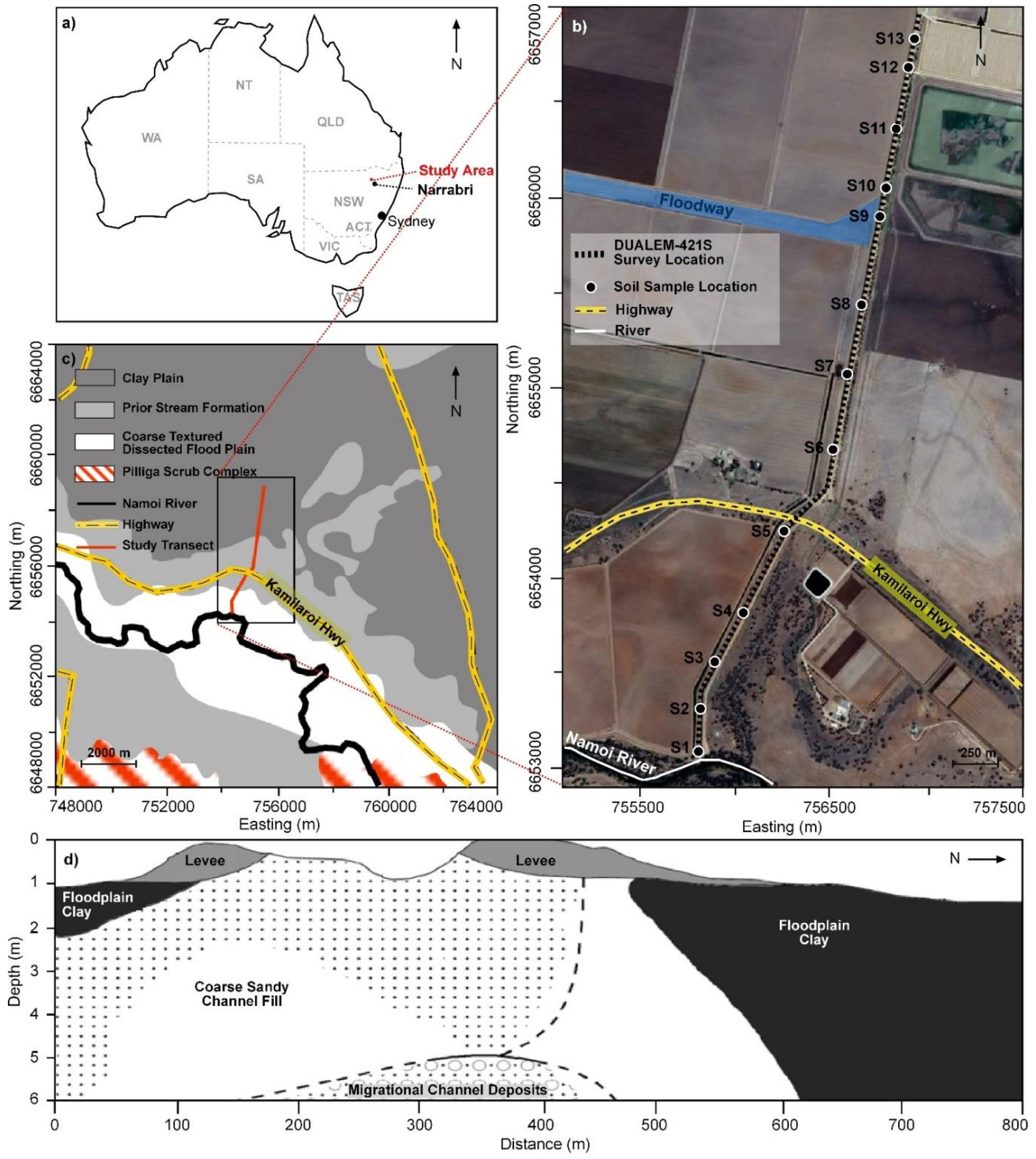
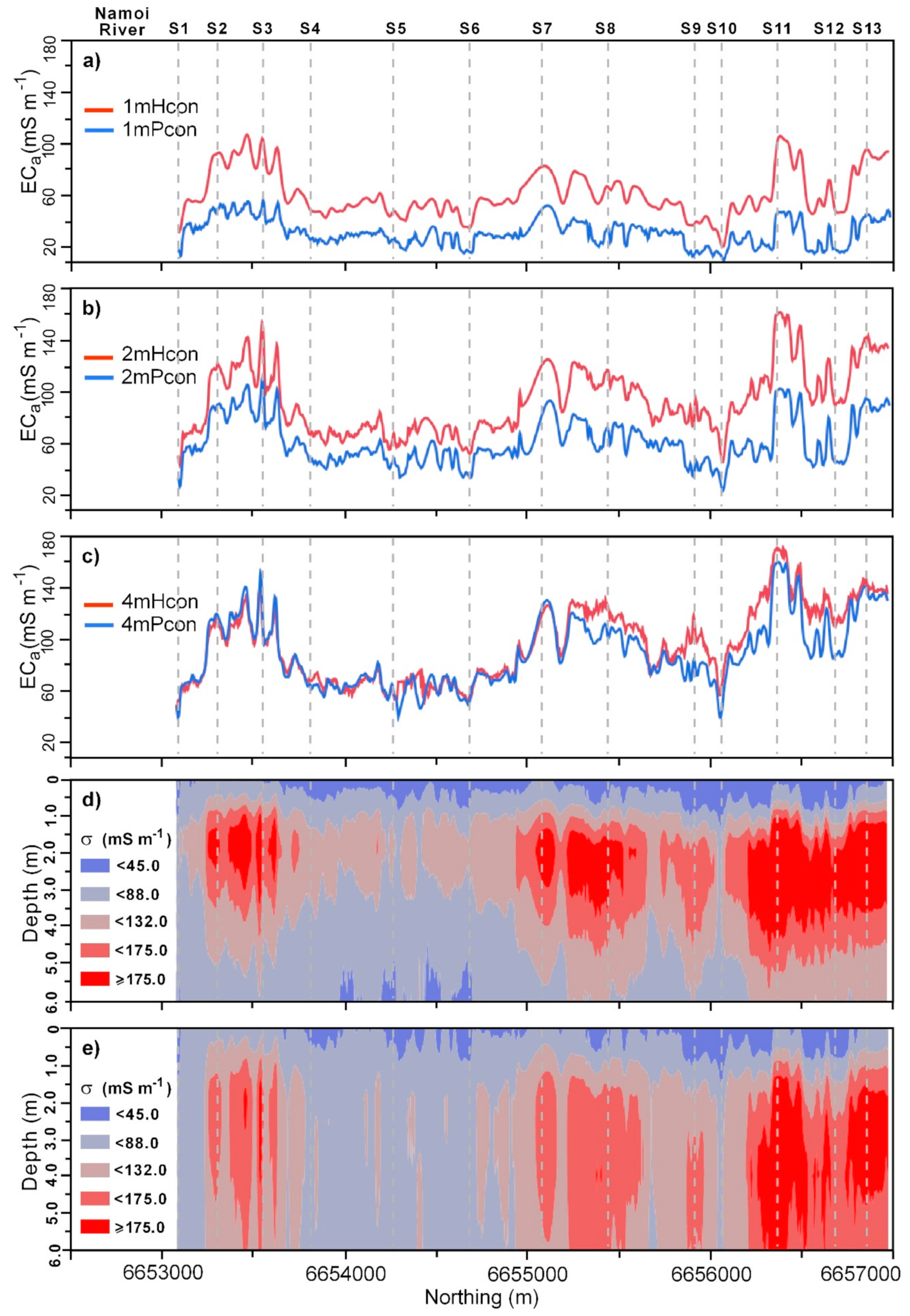
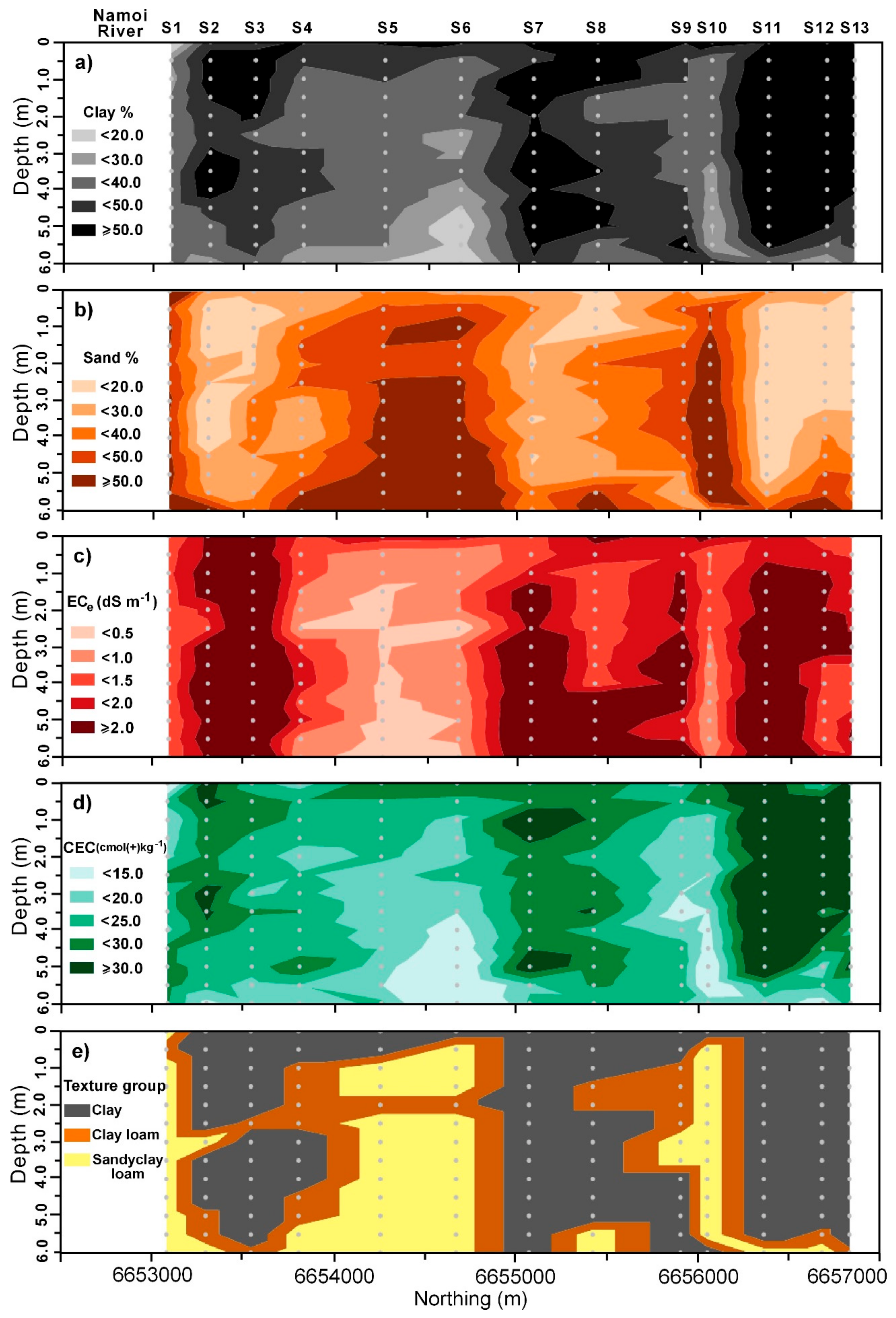
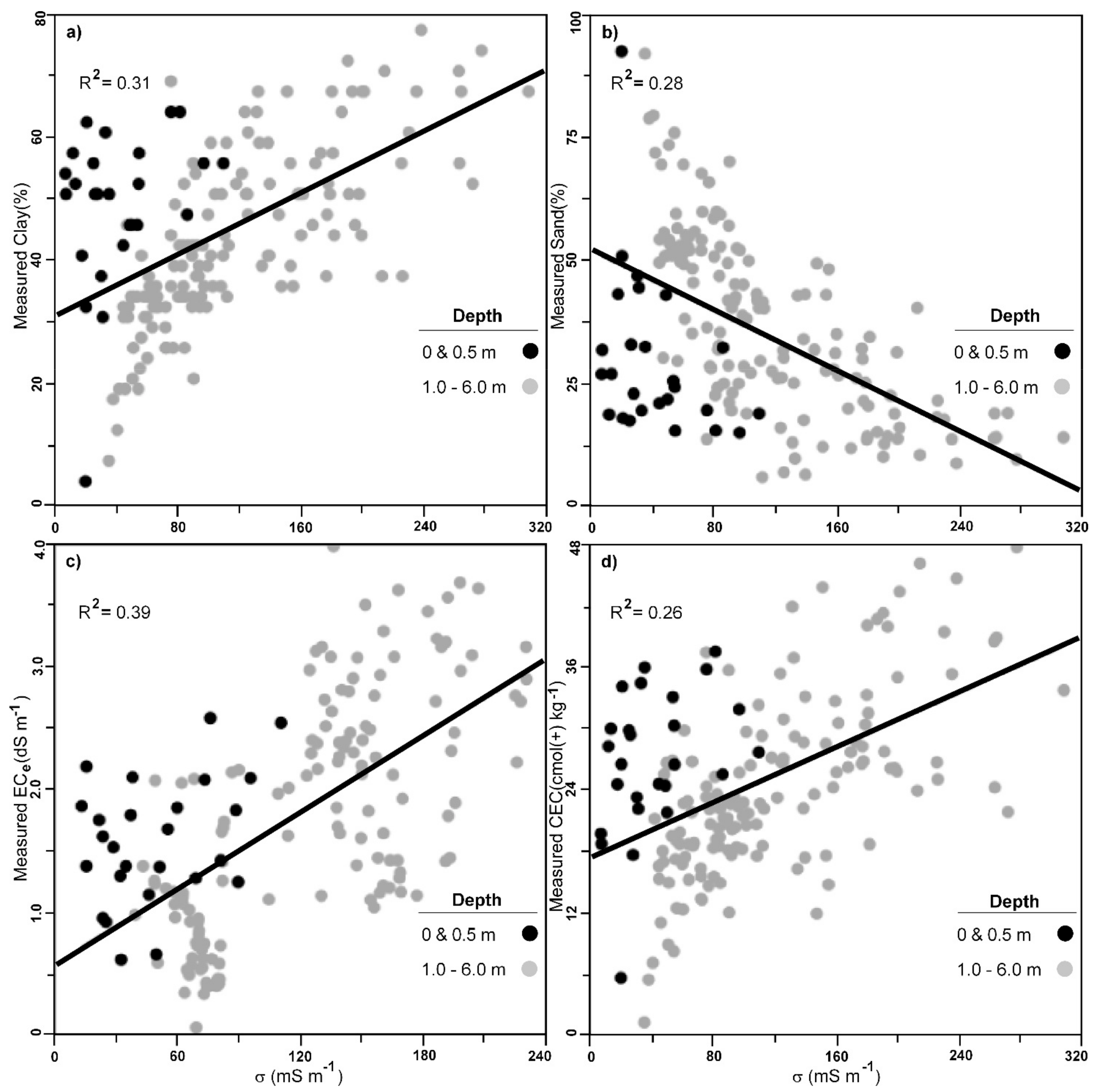
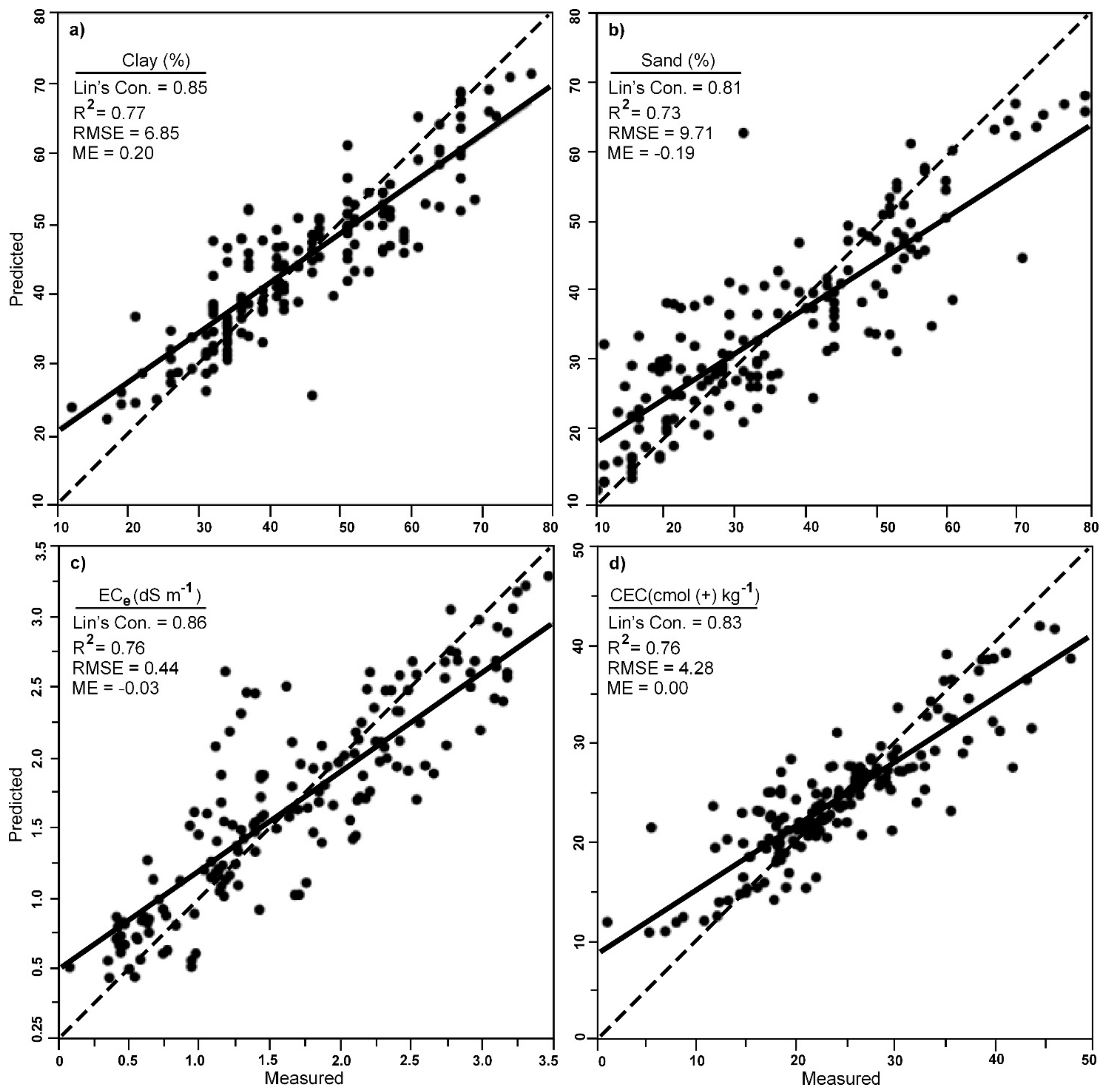

| DUALEM-421 | N | Min | Mean | Max | Median | CV (%) | SD | Skewness |
|---|---|---|---|---|---|---|---|---|
| Survey Data | ||||||||
| 1mHcon | 2959 | 21 | 62 | 107 | 57 | 28 | 18 | 0.7 |
| 1mPcon | 2959 | 11 | 32 | 57 | 31 | 31 | 10 | 0.4 |
| 2mHcon | 2959 | 44 | 91 | 161 | 85 | 28 | 26 | 0.6 |
| 2mPcon | 2959 | 24 | 61 | 111 | 56 | 28 | 17 | 0.7 |
| 4mHcon | 2959 | 48 | 95 | 172 | 90 | 30 | 29 | 0.5 |
| 4mPcon | 2959 | 40 | 89 | 161 | 83 | 30 | 26 | 0.6 |
| Calibration data | ||||||||
| 1mHcon | 13 | 23 | 63 | 106 | 49 | 47 | 29 | 0.3 |
| 1mPcon | 13 | 16 | 32 | 56 | 26 | 50 | 16 | 0.4 |
| 2mHcon | 13 | 48 | 97 | 161 | 92 | 41 | 40 | 0.3 |
| 2mPcon | 13 | 30 | 63 | 110 | 47 | 47 | 29 | 0.4 |
| 4mHcon | 13 | 53 | 103 | 171 | 115 | 38 | 40 | 0.1 |
| 4mPcon | 13 | 43 | 95 | 161 | 89 | 44 | 42 | 0.3 |
| Soil Properties | N | Min | Mean | Max | Median | CV (%) | SD | Skewness |
|---|---|---|---|---|---|---|---|---|
| Clay (%) | 169 | 4.00 | 44.18 | 77.33 | 42.33 | 31.99 | 14.13 | 0.02 |
| Silt (%) | 169 | 0.73 | 20.29 | 41.23 | 19.77 | 38.77 | 7.88 | 0.19 |
| Sand (%) | 169 | 5.90 | 35.54 | 92.40 | 31.87 | 51.51 | 18.31 | 0.63 |
| ECe (dS m−1) | 169 | 0.08 | 1.73 | 3.99 | 1.64 | 52.00 | 0.90 | 0.36 |
| CEC (cmol(+)kg−1) | 169 | 1.31 | 24.41 | 47.67 | 23.32 | 34.53 | 8.43 | 0.33 |
| pH1:5 | 169 | 4.47 | 8.30 | 9.65 | 8.4 | 9.15 | 0.76 | −1.16 |
| Soil Properties | R2 | |
|---|---|---|
| 0.3 S2 CF | 1.8 S2 CF | |
| Clay (%) | 0.31 *** | 0.25 *** |
| Silt (%) | 0.05 ** | 0.06 ** |
| Sand (%) | 0.28 *** | 0.23 *** |
| ECe (dS m−1) | 0.22 *** | 0.39 *** |
| CEC (cmol(+)kg−1) | 0.26 *** | 0.17 *** |
| pH1:5 | 0.18 *** | 0.32 *** |
© 2020 by the authors. Licensee MDPI, Basel, Switzerland. This article is an open access article distributed under the terms and conditions of the Creative Commons Attribution (CC BY) license (http://creativecommons.org/licenses/by/4.0/).
Share and Cite
Zare, E.; Li, N.; Khongnawang, T.; Farzamian, M.; Triantafilis, J. Identifying Potential Leakage Zones in an Irrigation Supply Channel by Mapping Soil Properties Using Electromagnetic Induction, Inversion Modelling and a Support Vector Machine. Soil Syst. 2020, 4, 25. https://doi.org/10.3390/soilsystems4020025
Zare E, Li N, Khongnawang T, Farzamian M, Triantafilis J. Identifying Potential Leakage Zones in an Irrigation Supply Channel by Mapping Soil Properties Using Electromagnetic Induction, Inversion Modelling and a Support Vector Machine. Soil Systems. 2020; 4(2):25. https://doi.org/10.3390/soilsystems4020025
Chicago/Turabian StyleZare, Ehsan, Nan Li, Tibet Khongnawang, Mohammad Farzamian, and John Triantafilis. 2020. "Identifying Potential Leakage Zones in an Irrigation Supply Channel by Mapping Soil Properties Using Electromagnetic Induction, Inversion Modelling and a Support Vector Machine" Soil Systems 4, no. 2: 25. https://doi.org/10.3390/soilsystems4020025
APA StyleZare, E., Li, N., Khongnawang, T., Farzamian, M., & Triantafilis, J. (2020). Identifying Potential Leakage Zones in an Irrigation Supply Channel by Mapping Soil Properties Using Electromagnetic Induction, Inversion Modelling and a Support Vector Machine. Soil Systems, 4(2), 25. https://doi.org/10.3390/soilsystems4020025






